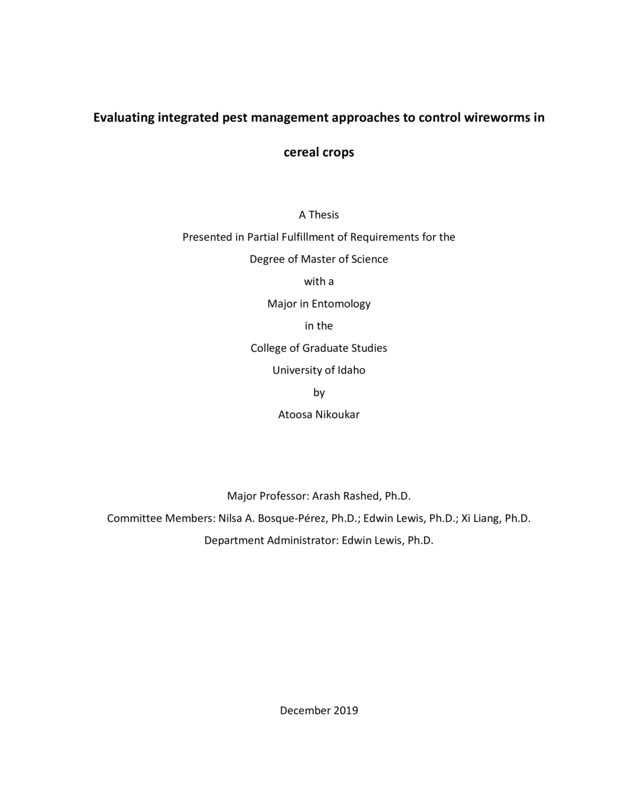Evaluating integrated pest management approaches to control wireworms in cereal crops
Nikoukar, Atoosa. (2019-08). Evaluating integrated pest management approaches to control wireworms in cereal crops. Theses and Dissertations Collection, University of Idaho Library Digital Collections. https://www.lib.uidaho.edu/digital/etd/items/nikoukar_idaho_0089n_11688.html
- Title:
- Evaluating integrated pest management approaches to control wireworms in cereal crops
- Author:
- Nikoukar, Atoosa
- Date:
- 2019-08
- Keywords:
- bifenthrin biological control Entomopatogenic Nematodes IPM Rotation crop wireworms
- Program:
- Plant, Soil and Entomological Sciences
- Subject Category:
- Entomology; Agriculture
- Abstract:
-
Wireworms are considered a major re-emergence pest of many crops including wheat, barely, potato, corn and legumes in the Pacific Northwest and Intermountain regions of the USA. Neonicotinoid seed treatments, the only group of insecticides registered in cereals against wireworms, have failed to provide an acceptable level of protection against wireworms. Thus, there is a need to test alternative methods, to be employed as components of an integrated management protocol. Focusing on one of the most damaging species in the PNW, the sugar beet wireworm Limonius californicus, we conducted greenhouse studies to evaluate (1) the efficacy of commercially available and locally-collected entomopathogenic nematodes, and (2) the effects of insecticide application in a rotation crop (pea) in reducing wireworm damage in subsequent wheat. Field collected nematode Steinernema feltiae isolate Kyle-F1 caused significantly higher mortality (64%) in L. californicus larvae than commercial nematode strains including Steinernema carpocapsae (30%), Heterorhabtidis bacteriophora (6.6%) and S. feltiae (10%). The results suggest that field collected nematode isolates, which are well-adapted to environmental conditions can be a potential candidate against wireworms in the field. We also detected that in-furrow application of bifenthrin, a pyrethroid insecticide with mortality effect on wireworm in pea, as rotation crop with cereals, was effective to reduce wireworm damage in subsequent wheat. Bifenthrin-treated pea followed by wheat treatments caused significantly higher mortality (82%) in L. californicus larvae than untreated pea. Moreover, 30% higher emergence was observed in wheat treatments followed by bifenthrin-treated pea. Our results indicate that integration of both chemical approaches and cultural practices (crop rotation) could be a more effective management strategy for wireworm control.Wireworms are considered a major re-emergence pest of many crops including wheat, barely, potato, corn and legumes in the Pacific Northwest and Intermountain regions of the USA. Neonicotinoid seed treatments, the only group of insecticides registered in cereals against wireworms, have failed to provide acceptable level of protection against wireworms. Thus, there is a need to test alternative methods, to be employed as components of an integrated management protocol. Focusing on one of the most damaging species in the PNW, the sugar beet wireworm Limonius californicus, we conducted greenhouse studies to evaluate (1) the efficacy of commercially available and locally-collected entomopathogenic nematodes, and (2) the effects of insecticide application in a rotation crop (pea) in reducing wireworm damage in subsequent wheat. Field collected nematode Steinernema feltiae isolate Kyle-F1 caused significantly higher mortality (64%) in L. californicus larvae than commercial nematode strains including Steinernema carpocapsae (30%), Heterorhabtidis bacteriophora (6.6%) and S. feltiae (10%). The results suggest that field collected nematode isolates, which are well-adapted to environmental conditions can be a potential candidate against wireworms in the field. We also detected that in-furrow application of bifenthrin, a pyrethroid insecticide with mortality effect on wireworm in pea, as rotation crop with cereals, was effective to reduce wireworm damage in subsequent wheat. Bifenthrin-treated pea followed by wheat treatments caused significantly higher mortality (82%) in L. californicus larvae than untreated pea. Moreover, 30% higher emergence was observed in wheat treatments followed by bifenthrin-treated pea. Our results indicate that integration of both chemical approaches and cultural practices (crop rotation) could be a more effective management strategy for wireworm control.
- Description:
- masters, M.S., Plant, Soil and Entomological Sciences -- University of Idaho - College of Graduate Studies, 2019-08
- Major Professor:
- Rashed, Arash
- Committee:
- Bosque-Perez, Nilsa A.; Lewis, Edwin; Liang, Xi
- Defense Date:
- 2019-08
- Identifier:
- Nikoukar_idaho_0089N_11688
- Type:
- Text
- Format Original:
- Format:
- application/pdf
- Rights:
- In Copyright - Educational Use Permitted. For more information, please contact University of Idaho Library Special Collections and Archives Department at libspec@uidaho.edu.
- Standardized Rights:
- http://rightsstatements.org/vocab/InC-EDU/1.0/

